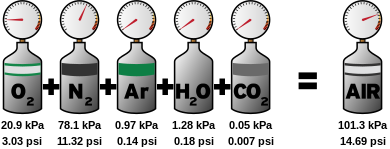
Back Dalton se wet Afrikaans قانون دالتون Arabic Dalton qanunları Azerbaijani ডাল্টনের সূত্র Bengali/Bangla Llei de Dalton Catalan Daltonův zákon parciálních tlaků Czech Дальтон саккунĕ CV Daltons lov Danish Partialdruck#Dalton-Gesetz German Ley de las presiones parciales Spanish

Dalton's law (also called Dalton's law of partial pressures) states that in a mixture of non-reacting gases, the total pressure exerted is equal to the sum of the partial pressures of the individual gases.[1] This empirical law was observed by John Dalton in 1801 and published in 1802.[2] Dalton's law is related to the ideal gas laws.
- ^ Silberberg, Martin S. (2009). Chemistry: the molecular nature of matter and change (5th ed.). Boston: McGraw-Hill. p. 206. ISBN 9780073048598.
- ^ J. Dalton (1802), "Essay IV. On the expansion of elastic fluids by heat," Memoirs of the Literary and Philosophical Society of Manchester, vol. 5, pt. 2, pages 595–602; see page 600.
© MMXXIII Rich X Search. We shall prevail. All rights reserved. Rich X Search